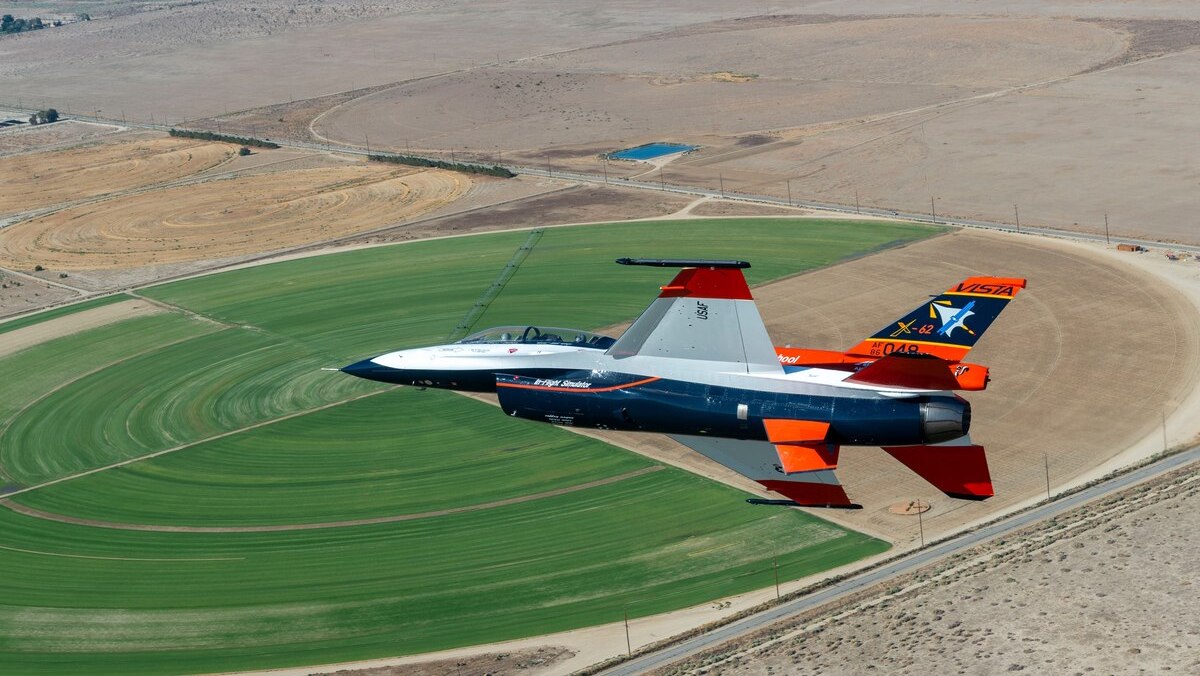DoD artificial intelligence agents successfully pilot fighter jet
EDWARDS AIR FORCE BASE, Calif. —
A joint Department of Defense team executed 12 flight tests in which artificial intelligence, or AI, agents piloted the X-62A Variable Stability In-Flight Simulator Test Aircraft, or VISTA, to perform advanced fighter maneuvers at Edwards Air Force Base, Calif., Dec. 1-16, 2022. Supporting organizations included the U.S. Air Force Test Center, the Air Force Research Laboratory, or AFRL, and Defense Advanced Research Projects Agency, or DARPA.
AFRL’s Autonomous Air Combat Operations, or AACO, and DARPA’s Air Combat Evolution, or ACE, AI-driven autonomy agents piloted the U.S. Air Force Test Pilot School’s X-62A VISTA to perform advanced fighter maneuvers. AACO’s AI agents performed one-on-one beyond-visual-range, or BVR, engagements against a simulated adversary, and ACE’s AI agents performed within-visual-range maneuvering, known as dogfighting, against constructive AI red-team agents.
Both teams’ AI agents executed autonomous tactical maneuvering while maintaining real-world airspace boundaries and optimizing aircraft performance. These tests are built upon the X-62A VISTA upgrade, which allows the X-62 to be controlled by AI-driven autonomy algorithms and mimic flight characteristics of fixed-wing vehicles such an MQ-20 or as in these tests, an F-16.
In several instances, pilots completed the tests for ACE and AACO within hours of each other after engineers switched autonomy algorithms onboard the X-62A in minutes.
“The X-62A is rapidly accelerating the speed at which autonomy algorithms are tested,” said an official familiar with the experimentation. “The X-62A VISTA Gen2020 upgrade transformed the NF-16D VISTA into the X-62A VISTA to support autonomy testing such as this test campaign.”
The official said the rapid changes that can be achieved safely on VISTA allow researchers to respond to lessons learned quickly, improving capabilities during test windows.
“The X-62A VISTA team has proven with this test campaign that they are capable of complex AI test missions that accelerate the development and testing of autonomy capabilities for the DOD,” said Dr. Malcolm Cotting, the director of Research for the U.S. Air Force Test Pilot School.
Cotting said the VISTA team will continue to support rapid advanced autonomy tests and push the state-of-the-art in flight testing.
“The X-62 is a flight test accelerator,” the experimentation official said. “It allows the USAF to rapidly execute tactical autonomy algorithm and fixed-wing vehicle model flight tests. These tests generate data that is used to improve the algorithms and vehicle models at a remarkably fast pace,” he added. “The X-62 illustrates the value of using crewed, surrogate vehicles that possess tactical performance characteristics as autonomy test assets.”
The experimentation official said the joint team will continue leveraging the X-62 to test and evaluate autonomy capabilities and uncrewed vehicle models.
“After training our AI-driven autonomy agents using high performance computing and modeling and simulation, it is critical that we fly these agents to validate the difference from the simulator to live flights,” said an AACO official. “Having an aircraft like the X-62 is critical to rapid flight testing of these autonomous behaviors.”
The design of the X-62’s safety trip system is key to accelerating autonomy test, the AACO official added. The AACO team can fly, test and update agents based on flight data and then rapidly fly the new AI agents again within hours, without encountering airworthiness or safety issues.
“Across all domains, research moves only as fast as the tools permit,” said Lt. Col. Ryan Hefron, DARPA ACE program manager. “VISTA’s recent upgrade makes it a much more effective test bed by enabling rapid integration and safe testing of AI-driven autonomy. It allowed us to accelerate full-scale flight test of AI-driven autonomy by at least a year,” he said.
AACO and ACE are autonomy programs focused on developing AI-driven autonomy for airborne tactical platforms. The goal of AACO is to develop and fly an advanced AI-driven autopilot capable of performing aviate and navigate functions and autonomous behaviors such as advanced intelligence, surveillance and reconnaissance and BVR combat.
DARPA’s ACE program aims to develop trusted, scalable, human-level, AI-driven autonomy for air combat by using human-machine collaborative dogfighting as its challenge problem.
Both programs recognize the value and need for the X-62 and similar testbeds, which are critical for the maturation of AI-driven autonomy capabilities and new uncrewed vehicle model designs, the experimentation lead said.
For more information, please contact 412th Test Wing Public Affairs: 412TW.PA.mediarelations@us.af.mil
Learn more:
- WIRED. The US Air Force Is Moving Fast on AI-Piloted Fighter Jets. After successful autonomous flight tests in December, the military is ramping up its plans to bring artificial intelligence to the skies. 08 MAR 2023
- Robotic fighter jets could soon join military pilots on combat missions. Here’s why. The fast-flying drones would scout enemy locations and draw fire that otherwise would be directed at human pilots.
- The rise of the AI fighter pilot: Self-flying F-16 jet takes off, fights against other aircraft and lands – without ANY human help. A modified F-16 fighter jet has performed combat manoeuvres autonomouslyTest flights took place in December 2022 at a US Air Force base in CaliforniaThis marks the first time AI has been engaged on a tactical aircraft
#AI successfully pilots fighter jet ✈️
.#ICYMI @deptofdefense artificial intelligence agents successfully pilot a fighter jet making AI history! Using a X-62A VISTA, this was a combined team effort from @afresearchlab, @lockheedmartin, @darpa and @EdwardsAFB.
.
@officialafmc pic.twitter.com/hsfgaw0kVx— Edwards Air Force Base (@EdwardsAFB) February 15, 2023


